
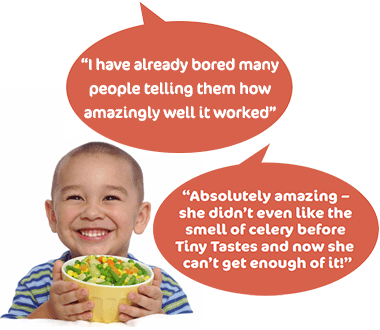
Hello Mums, Dads and anyone involved in feeding young children.
Tiny Tastes is a pack designed to help parents to get their children eating vegetables. Containing full instructions, record charts and stickers, these packs are now available to buy for £5.99 each plus £2.00 postage and packing. On these pages, you can find out more about the research behind Tiny Tastes, read comments from people who’ve already tried it and buy it for yourself.
Tiny Tastes will encourage your child to try vegetables by making it fun. Our extensive research at University College London has shown that, after tasting a new vegetable at least 10 times even the most reluctant children like it more and will eat more of it. Playing Tiny Tastes will get your child familiar with lots of vegetables and the more familiar the vegetables become the more your child will like them. Tiny Tastes works with all ages – you could even try it yourself!
Dr Lucy Cooke is a Senior Research Psychologist in the Health Behaviour Research Centre of the Department of Epidemiology and Public Health at University College London. She is a member of the National Steering Group for Childhood Feeding Disorders and a Trustee of the charity the First Steps Nutrition Trust. After acquiring a first class degree in Psychology at UCL, Lucy went on to complete a Master’s degree in Health Psychology and was awarded a PhD for research into children’s eating habits in 2006.
 Her research area is the development and modification of young children’s eating habits. She has led a number of projects within the Research Centre including the ‘Poppets’ study, which aimed to characterise aspects of family food environments associated with healthier and less healthy dietary patterns in preschool children using a survey methodology. The second phase of this project involved the testing of a habit theory-based intervention to reduce children’s unhealthy drinking and snacking behaviours and to increase fruit and vegetable consumption. Lucy was principal investigator on a NPRI/MRC funded project investigating the influence of incentives on children’s consumption of vegetables which inspired the development of the Tiny Tastes pack. She is also task leader for a randomised controlled trial of a weaning intervention – part of the EU FP7 HabEat project.
Her research area is the development and modification of young children’s eating habits. She has led a number of projects within the Research Centre including the ‘Poppets’ study, which aimed to characterise aspects of family food environments associated with healthier and less healthy dietary patterns in preschool children using a survey methodology. The second phase of this project involved the testing of a habit theory-based intervention to reduce children’s unhealthy drinking and snacking behaviours and to increase fruit and vegetable consumption. Lucy was principal investigator on a NPRI/MRC funded project investigating the influence of incentives on children’s consumption of vegetables which inspired the development of the Tiny Tastes pack. She is also task leader for a randomised controlled trial of a weaning intervention – part of the EU FP7 HabEat project.
Since 2012, Dr Cooke has also been working with Weight Concern to develop evidence-based guidance in child feeding and related issues for health professionals and parents.
Until about halfway through their second year, most babies are reasonably enthusiastic eaters - happy to eat a wide range of different foods and willing to try something new. Then seemingly overnight, well-liked foods start being rejected, and anything unfamiliar is treated with the utmost suspicion. What scientists call ‘neophobia’ has set in and it is very common indeed. Meaning literally, ‘fear of the new’, neophobia, together with a general pickiness emerges when children are between 18 months and two years old. Evolutionary psychologists believe that when humans were cave-dwellers, such a tendency would have stopped young and newly-mobile children eating unfamiliar plants or berries which might be poisonous. Indeed research has shown that it is the very foods we most want children to eat – fruit and vegetables - that are most often rejected at this stage. Knowing all this is not much help though, when your child has refused to eat anything green or remotely nutritious and is existing on a diet of plain pasta and orange juice! Mothers know that children need plenty of fruit and vegetables so they resort to a wide range of strategies to achieve the vital 5 a day.
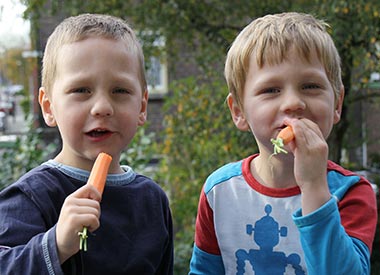
More than half the mothers surveyed in the USA and the UK, say they offer their children rewards of sweets or treats in exchange for eating healthy foods, and most feel that it works. On the other hand, many of them feel that there is something not quite right about this practice and some of the experimental evidence suggests that it can have negative effects. For example, some studies have shown that if you offer ice cream as a reward for eating peas, your child may grow to like the ice cream even more, and the peas even less than they did before. And if you decide to stop offering the ice cream after a while, then peas may be rejected once again. Not quite the outcome we were looking for!
There is no doubt that hiding vegetables in a pasta sauce is an effective way of getting them eaten, but there is a down side to this practice – your child won’t actually taste the vegetables. If they don’t taste them, they won’t get to like them and if they catch you doing it, you are back to square one!
When you have tried every other method of getting your child to eat, getting cross is sometimes unavoidable. Hard as it sometimes is, keeping your temper and avoiding the use of threats and punishment is really important. When mealtimes become a battlefield, children start to associate certain foods (usually vegetables) with conflict and unhappiness. The good news is that scientists working in the area of eating behavior have developed and tested some feeding strategies that actually work to increase children’s liking for vegetables, rather than just getting them to consume them under sufferance.
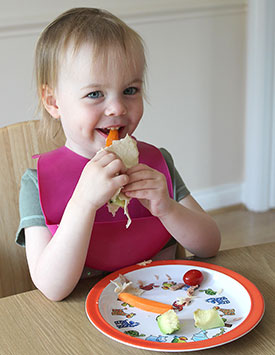
Most mothers say that if their child rejects a food on 3-5 occasions, they give up and don’t offer it again. What the research shows is that this is simply not enough to change preferences. Children aged from 2-5 years need to taste something between 10-15 times before it becomes familiar and accepted. That may sound daunting and even impossible, but tiny tastes are all that is needed. Here’s how to do it.
In a recent study, researchers found that children liked the vegetable more and ate much more of it after they had tasted it at least ten times. If you have ever tried to give up sugar in your tea or coffee then you will know that this works for adults too. At first it tastes horrible without sugar, but after a while you prefer it that way.
Of course, there are some children who simply won’t agree to try anything and this was the inspiration for the research that led to the production of the Tiny Tastes pack. We set out to investigate whether we non-food rewards might encourage fussy eaters to taste new foods without the negative effects mentioned earlier.
In our first study, we went to primary schools and worked with the Reception and Year 1 children giving them tastes of vegetables that they weren’t keen on every day and rewarded some of them with stickers. Other children also tasted the vegetables, but didn’t get a sticker. What we found was that getting a sticker every day for trying a disliked vegetable, made even the most reluctant children taste it. After at least 10 tastings, children liked it more and ate more and this didn’t change even after we stopped giving them stickers. In the 2nd study we visited children at home and asked their parents or carers to carry out the daily tasting and sticker reward procedure. We got the same positive results in this study and parents and carers said how much they had enjoyed using Tiny Tastes.
Use of rewards to promote healthy eating in children is commonplace but remains controversial because rewards are suspected of undermining intrinsic motivation.
A cluster-randomized trial with 422 4-6 year olds assessed the short and longer-term impact on acceptance of a disliked vegetable of systematic taste exposure (12 daily ‘tiny tastes’) paired with either tangible reward (stickers), social reward (praise) or no reward, compared with a no-treatment control condition. Liking and intake in a free-choice consumption task were assessed pre- and post-intervention and at 1 and 3 month’s follow-up.
All three exposure conditions increased liking more than the control condition, with no differences between conditions. Effects were maintained at follow-up. Both reward conditions increased consumption, with effects maintained for 3 months, but the effects of exposure alone were non-significant by 3 months.
These results indicate that external rewards do not necessarily undermine intrinsic motivation and may be useful in promoting healthy eating.
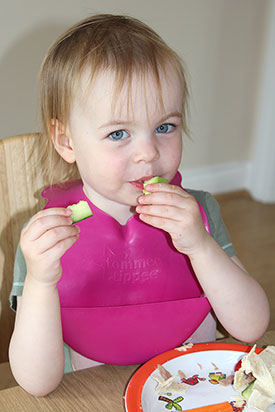
The use of rewards to encourage children to eat healthily is controversial. However, researcher-led interventions have shown that incentives combined with taste exposure can increase both intake and liking. To date, this has not been tested in the home setting. The aim of the study was to test the hypothesis that parent-administered repeated taste exposures to an initially-disliked vegetable combined with reward will increase children’s liking and intake, and to compare the effects of tangible and social rewards.
This was a randomised controlled trial, in which families with children age 3-4yrs (n=173) were randomly assigned to exposure + tangible reward (sticker), exposure + social reward (praise), or no-treatment control conditions, after a pre-test assessment where a target vegetable was selected for each child. In the intervention groups, parents offered their child 12 daily tastes of the vegetable, giving either praise or a sticker for tasting. No specific advice was given to the control group. Assessments of intake and liking of the target vegetable were conducted by researchers immediately after the intervention period, and 1 and 3 months later.
Children receiving exposure + tangible rewards increased their intake and liking of their target vegetable significantly more than children in the control group. Differences were maintained at 3-month follow-up. Increases in intake and liking in the exposure + social reward group were not statistically significantly different from the control group.
The findings of this home-based study support parental use of tangible rewards with repeated taste exposures to improve children’s diets.
Repeated taste exposure, in combination with small rewards, has been shown to increase children’s acceptance of disliked foods. However, previous studies have used direct contact with researchers or professionals for the implementation of the repeated exposure procedure. If mailed taste exposure instructions to parents produced comparable outcomes, this could be a cost-effective and easily disseminable strategy to promote healthier diets in children.
This randomized controlled study aimed to test the efficacy and acceptability of mailed materials giving instructions on taste exposure as a means of increasing acceptance of vegetables in pre-school children. Participants were families of three year-old twins from the Gemini cohort who took part between March 2011 and April 2012. Families were randomized to a mailed intervention or a no treatment control condition. The intervention involved offering each child 14 daily tastes of a disliked (target) vegetable with a small reward (a sticker) if the child complied. Outcomes were the child’s intake of the target vegetable (number of pieces) and parent reports of the child’s liking at two baseline (T1, T2) and one post-intervention behavioral assessment (T3).
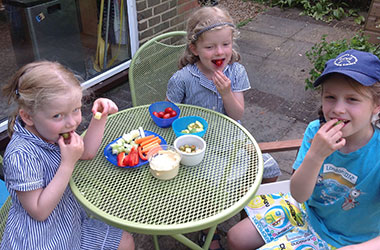
Record sheets with intake and liking data from T1, T2 and T3 were returned for 472 children, of which 442 were complete (94%). Over the intervention period (T2 to T3) intake and liking of the target vegetable increased significantly more in the intervention group than the control group. Acceptability of the procedure was very high among parents who completed the protocol.
Mailed instructions for taste exposure were effective in increasing children’s acceptance of an initially disliked vegetable. These results support the value of parent-administered exposure to increase children’s vegetable acceptance, and suggest that it can be carried out without direct health professional contact.
We weaned the children using vegetables and my husband and I made sure we ate lots of vegetables in front of them but they were still suspicious of new things and reluctant to try some foods, especially green vegetables. My husband would try to make yummy faces when eating celery but even he didn’t really like it and I think they picked up on that. I was impressed when the pack arrived, it looked really good and the twins were excited, they really liked the stickers. The twins now ask for vegetables and when I cook with mushrooms I have to chop them up and get them into the pan quickly, otherwise the children will be in the kitchen trying to eat them! I now keep cherry tomatoes and sugar snap peas in a bowl in the fridge and they just disappear, which is amazing because Eilony used to hate tomatoes. I also give them portions of raw vegetables in their school lunch boxes and they always eat them and enjoy them. I can't even remember which vegetable we played Tiny Tastes with first because we have done it with so many; tomatoes, sugar snap peas, mushrooms, celery and so on.
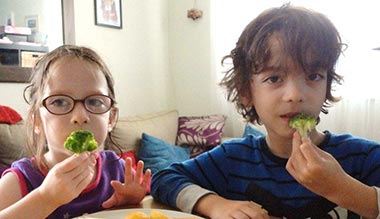

I think it made them more willing to try new things. Overall they are now good at eating their vegetable, even cooked vegetable like broccoli and cauliflower they are keen to eat. I am surprised that now, even two years later they are still happy to try things, I expected them to revert back to that normal children thing of refusing to eat certain foods but they haven't.
I think Tiny Tastes works so well because it involves the children and makes it into a game ...For me, the fact that Tiny Tastes is based on scientific research is really important. I don't take anything just on word of mouth and the fact there is scientific reasons behind it and it's not just an 'old wives tale' is really important. I think the fact that Tiny Tastes is open and honest and involves the children is one of the main reasons it works so well; I don't really like other methods of getting children to eat vegetables, like blending them or hiding them in other foods. It was so easy it took the stress out of getting the children to try things, it was just a case of grabbing some raw vegetable, washing it and playing the game and they were really enthusiastic about it as well which made it so much less stressful.


I have been telling everyone I know with young children about Tiny Tastes. Now that Tiny Tastes packs are available to buy I will recommend them to everyone but I might also buy some myself to give as presents".